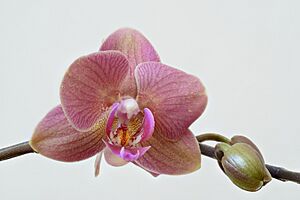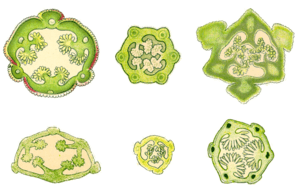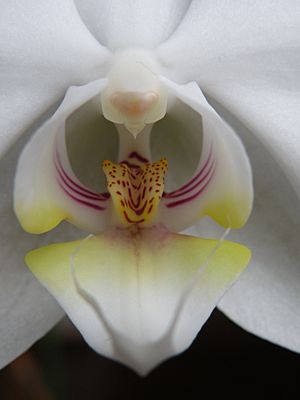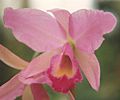Orchid facts for kids
Quick facts for kids OrchidaceaeTemporal range: Upper Cretaceous 80 mya – Recent
|
|
|---|---|
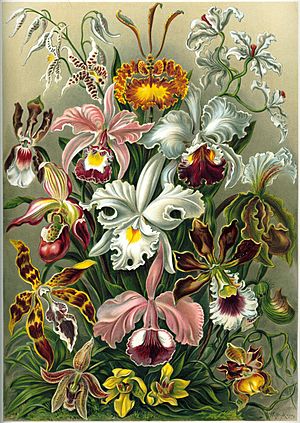 |
|
| From Ernst Haeckel's Kunstformen der Natur | |
| Scientific classification | |
| Kingdom: | |
| Division: | |
| Class: | |
| Order: | |
| Family: |
Orchidaceae
|
| Subfamilies | |
|
|
The orchids are a very large family of flowering plants, known scientifically as Orchidaceae. They are herbaceous plants, which means they have soft stems instead of woody ones. Orchids are also monocots, a group of flowering plants that have one seed leaf.
There are between 22,000 and 26,000 different species of orchids. They belong to about 880 different genera (groups of species). This means orchids make up a big part of all seed plants, about 6–11%. You can find orchids in almost every country in the world, except for Antarctica.
People have been growing orchids for thousands of years. They grow them for their beautiful flowers, for scientific study, or even for food. For example, vanilla comes from an orchid! Some orchids have very special ways of getting pollination done. The Lady's Slipper, for instance, can trap insects to make them pollinate its flower. There's even an Austrian orchid that grows underground and relies on ants for pollination. Many orchids are myco-heterotrophs. This means their roots need tiny fungi to help them break down food from the soil so the orchid can absorb it.
Contents
Where Orchids Grow
Colombia and Ecuador are home to many different orchid species. The Atlantic forest in Brazil has over 1500 species! Other places with a huge variety of orchids include the mountains in the southern Himalayas in India and China. The mountains of Central America and southeastern Africa also have many different kinds, especially the island of Madagascar.
Ecuador holds the record with 3,459 recorded species. After Ecuador, Colombia has 2,723 species. New Guinea has 2,717, and Brazil has 2,590 species in total.
In warm areas with lots of grass, or in dry savannas and rocky fields, orchids often grow in the ground. These ground orchids have strong underground roots. Sometimes, they have special storage parts called tubers. These tubers help protect them from cold weather or snow. They also help the orchids survive long periods of drought or fire. The tubers store the nutrients the plants need to bloom in the spring.
Sadly, some orchid species are becoming extinct in the wild. This mainly happens because people cut down forests to make room for agriculture.
Orchid Life Cycle
How Orchids Reproduce
Orchids have amazing and complex ways of getting pollination done. Charles Darwin wrote about these special methods in his 1862 book, The Fertilisation of Orchids. Orchids have developed unique systems for pollination. Since the chances of being pollinated can be low, orchid flowers often stay ready for a long time. Most orchids release their pollen in a single sticky mass. When pollination is successful, thousands of tiny ovules (which become seeds) can be fertilized.
Some orchids are quite dramatic! For example, the Catasetum orchid can actually shoot its sticky pollen with explosive force when an insect touches a special hair. This even knocks the pollinator off the flower!
Pollinators are often attracted to orchids by the flower's shape and bright colors. The flowers might also produce nice smells. In some very specialized orchids, like the Ophrys genus from Eurasia, the flower's lip (called the labellum) looks, feels, and smells like a female insect. This tricks male insects into trying to mate with the flower, which then causes pollination to happen.
Many orchids in tropical America are pollinated by male orchid bees. These bees visit the flowers to collect special chemicals they need to make their own perfumes to attract female bees. Each type of orchid places its pollen on a different part of a different bee species. This ensures that the right pollen goes to the right flower for proper cross-pollination. After pollination, the flower's sepals and petals fade and wilt, but they usually stay attached to the ovary.
There's even an underground orchid in Australia, Rhizanthella slateri, that never sees sunlight. It depends on ants and other insects that live in the soil to pollinate it. Some orchids mostly or completely rely on self-pollination. This is especially true in colder places where there aren't many pollinators around.
Orchid Fruits and Seeds
The ovary of an orchid flower usually grows into a capsule. This capsule splits open along three or six lines, but stays closed at both ends. It can take anywhere from two to 18 months for a capsule to ripen.
Orchid seeds are incredibly tiny and there are a huge number of them. Some species can have over a million seeds in just one capsule! After they ripen, they float away like dust or spores. These seeds don't have their own food supply (called endosperm). Because of this, they need to form a special partnership (a symbiosis) with fungi to get the nutrients they need to start growing. All orchid species rely on fungi to complete their lives. Since it's very hard for a tiny seed to find the right fungus, only a very small number of all the seeds released actually grow into adult plants.
When people grow orchids, the seeds usually take weeks to sprout. Gardeners have developed special ways to grow orchid seeds on a nutrient-rich gel. This way, the seeds don't need the fungus to germinate.
A common ingredient for growing orchids in artificial conditions is agar. This substance is mixed with a type of carbohydrate (like glucose) which provides good food for the seeds. Things like banana, pineapple, peach, tomato puree, or even coconut milk can be added. After the agar mixture is "cooked" in a clean, sterile way, it's poured into test tubes or jars where it turns into a gel.
Images for kids
-
Labelled image of Caladenia alpina
-
Labelled image of Diuris carinata
-
Cattleya Queen Sirikit 'Diamond Crown'
See also
 In Spanish: Orquídeas para niños
In Spanish: Orquídeas para niños


